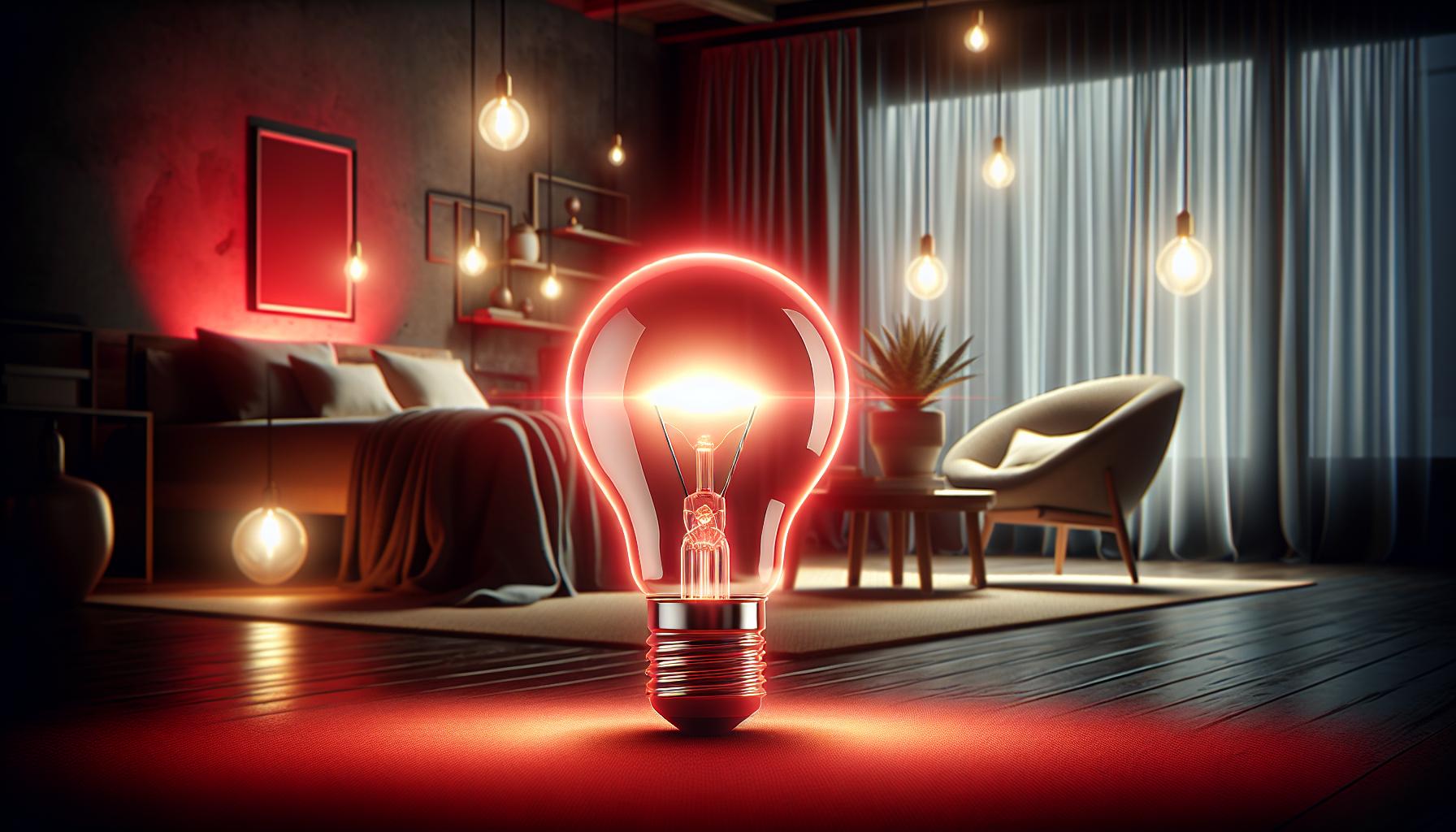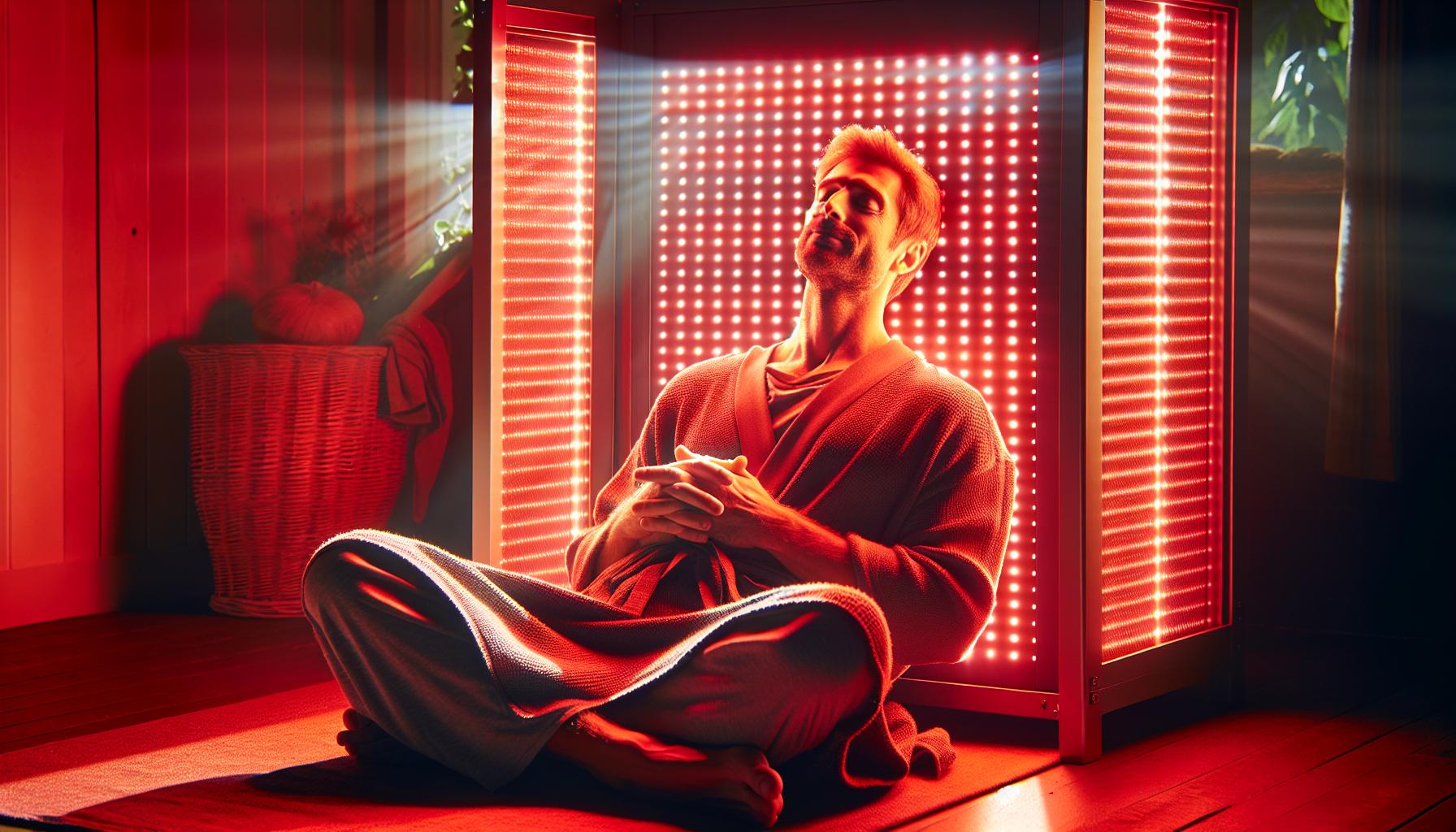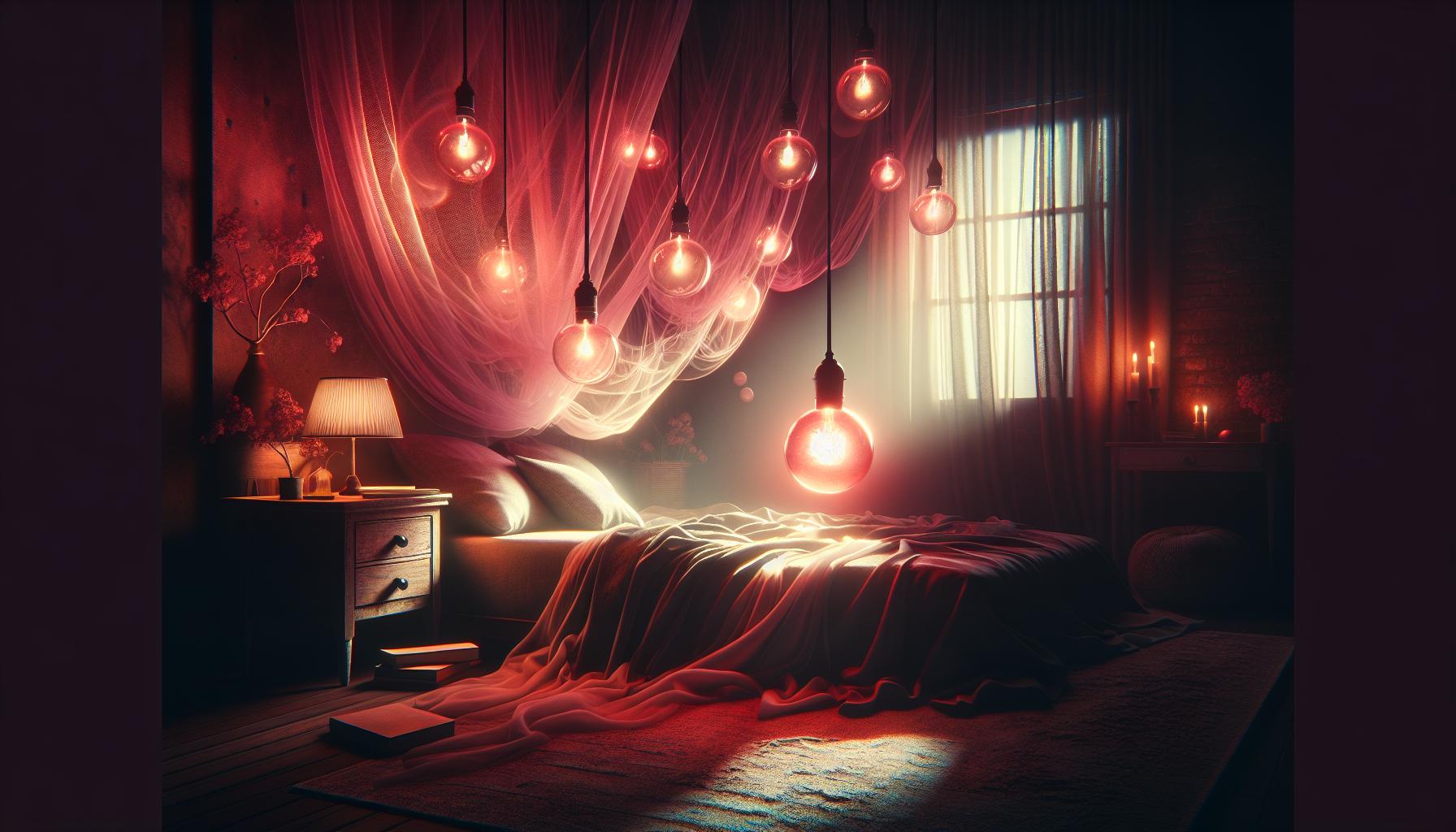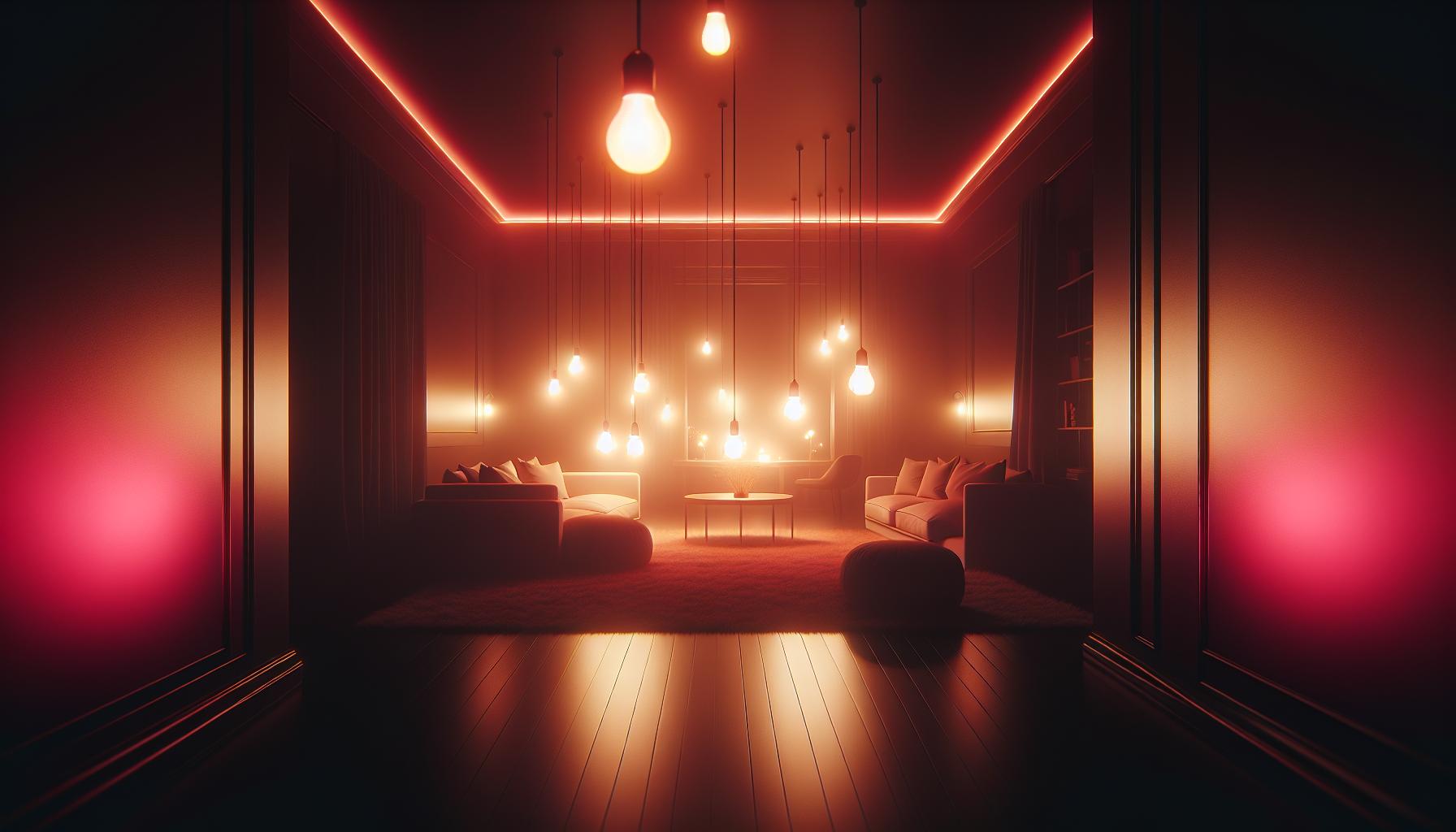Ever wondered if the color of your light bulbs could actually impact your health? It’s time to shine a light on red bulbs and their surprising benefits. From their soothing glow to potential health perks, red light might just be the unsung hero of your home’s lighting scheme.
You’ve probably heard about light therapy, but red light bulbs bring the wellness game right to your living room. They’re not just for photographers or dark rooms anymore! So, let’s dive into why flipping the switch to red could be a bright idea for your well-being.
The Impact of Light Bulb Color on Health
Delving deeper into the significance of light bulb colors, it’s essential to understand how they can affect your health. Just as you pick paint colors to influence the ambiance of a room, selecting the appropriate light bulb color can profoundly impact your physical and mental well-being.
Red light, in particular, is gaining attention for its potential health benefits. It’s thought to boost melatonin production, the hormone responsible for regulating sleep cycles. If you’re someone who loves a good DIY project, consider swapping out your bedroom’s standard bulbs with red ones to potentially improve sleep quality.
Beyond melatonin, red light may also contribute to reduced inflammation and pain relief. If you’ve ever felt the warmth of a sunset and found it calming, it’s no surprise that a red bulb could have a similar soothing effect. Lighting up your space with this hue might not only set a cozy mood but also promote physical relaxation.
But what about other colors? Blue light, often emitted by screens, is well-known for its stimulative properties that can disrupt sleep. In contrast, warm colors like red and orange are more conducive to relaxation and rest. Here’s a snapshot of how different light bulb colors can influence your health:
| Color | Impact on Sleep | Mood Influence |
|---|---|---|
| Red | May improve | Soothing |
| Blue | Can disrupt | Stimulative |
| Orange | May encourage | Relaxing |
| White | Varies | Depends on tone |
For your next home improvement escapade, consider how each room’s function aligns with these colors. Your home office might benefit from brighter, cooler tones to keep you alert, while your meditation corner could be the perfect spot for a red or orange glow.
Remember, it’s not just about aesthetics; it’s about how light infiltrates and interacts with your body. Whether you’re distressing furniture for that vintage charm or choosing a bulb for your reading nook, lighting is a key player in the overall harmony of your health and home.
What Makes Red Light Bulbs Different?
When you’re eyeing that aisle filled with a spectrum of colors, red light bulbs might just stand out as the unique choice for your home. Unlike the typical white or yellow lights, red light bulbs offer a specific wavelength that’s unlike the rest. This wavelength is often in the range of 620 to 750 nanometers, tapping into many of the health benefits that are currently lighting up the discussion in wellness circles.
Let’s dig a bit deeper. Red light has a lower color temperature compared to blue light, which means it’s less harsh on your eyes and your circadian rhythm. By harnessing the power of red light, you’re also potentially boosting your melatonin levels without the need for supplements or medication – natural remedies for the win!
Your body’s response to red light doesn’t stop there. You may find that inflammation soothes and pain eases when exposed to red light, which could be a game-changer if you’re looking for non-pharmaceutical methods to manage chronic conditions. Imagine relaxing in a room with a gentle red glow, easing your aches without lifting a finger.
On the practical side, if you’re a DIY enthusiast, swapping out light bulbs is a cinch, and it can instantly transform the ambiance of a room. Whether it’s your bedroom or a cozy reading nook, red light bulbs could make the space feel more inviting and restful. Plus, for those late-night creativity spurts or relaxation moments before bed, a red light bulb can keep the mood mellow, allowing you to unwind without the stimulating effects of blue or white light.
- Lower color temperature
- Boosts melatonin
- Reduces inflammation
- Provides pain relief
- Easy to install for DIYers
- Ideal for relaxation spaces
Remember, light isn’t just about seeing; it’s about feeling. The color and tone of the bulbs you choose are integral to your home’s harmony, potentially influencing the way you sleep, your mood, and overall wellness.
The Benefits of Red Light Therapy
« Can Light Bulbs Explode? Tips to Prevent Unexpected Shatters
Which Light Bulbs Are Yellow: Best Warm Glow Options Revealed »
You might think that light is just light, but red light therapy takes it to a whole new level. Beyond just swapping out your standard bulbs for red ones, red light therapy taps into specific wavelengths that provide therapeutic benefits. As a lighting enthusiast who loves DIY projects, you’ll be intrigued to know how these red waves of light can have such a positive impact on your health and wellness.
First off, red light therapy is renowned for its skin rejuvenation properties. If you’re into looking and feeling youthful, you’ll be pleased to learn that this therapy can stimulate collagen production, which is key to reducing wrinkles and improving overall skin tone. It’s like giving your skin a much-needed energy boost from the inside out!
Moreover, this isn’t just about cosmetics; red light therapy goes deeper. It’s been shown to enhance muscle recovery. After a strenuous DIY project or an intense workout, the soothing effect of red light can help your muscles bounce back faster, reducing soreness and inflammation. Imagine needing less downtime between your projects or fitness sessions – that’s the power of red light therapy.
For the data-driven DIYer, here’s a snapshot of some compelling research:
| Study | Benefit Observed |
|---|---|
| Journal of Athletic Training, 2016 | Increased muscle recovery |
| Dermatologic Surgery, 2014 | Improved skin complexion |
| Sleep Medicine Reviews, 2012 | Enhanced sleep quality |
But let’s not stop there. If you’re after a good night’s sleep, red light therapy might be just what the doctor ordered. It’s scientifically backed that red wavelengths can aid in melatonin production, setting you up for a restful slumber. This is particularly beneficial for any night owls who are looking to turn their evening wind-down routine into a restorative retreat.
And best of all, incorporating red light therapy into your home is a relatively straightforward DIY project. With various devices available, from bulbs to panels, you can customize your approach to fit your lifestyle and needs perfectly. Whether it’s setting up a relaxation corner in your bedroom or equipping your bathroom with skin-enhancing lights, the integration of red light therapy into your home can be as simple or sophisticated as you desire.
Red Light Bulbs and Sleep Quality
When considering the myriad solutions to improve sleep quality, don’t overlook the impact of the humble light bulb. Red light bulbs, more than just a decorative feature, possess unique properties that might contribute to better rest. Melatonin production, a key hormone for regulating sleep, is influenced by light. Unlike the blue light emitted from screens, which can suppress melatonin, red light bolsters melatonin production.
But you’re probably wondering how you can use this to your benefit. Well, replacing harsh white bulbs with red ones in your bedroom could create an environment conducive to winding down. Imagine transforming your sleeping space into a cozy, sleep-enhancing haven. A red light’s soft glow could signal to your body that it’s time to relax and make slipping into a restful slumber feel more natural.
Several studies have examined the effects of red light therapy on sleep disorders. Think of these studies as finding the best nightlight for your body’s needs. For instance, one study showed participants exposed to red light experienced improved sleep quality.
To integrate red light therapy into your nightly routine, consider these simple steps:
- Swap out white bulbs: Replace bedroom and bathroom bulbs with red light bulbs to avoid exposure to sleep-disrupting blue light at night.
- Timing is key: Use red light sources in the evenings for optimal melatonin production leading up to bedtime.
- Consistency matters: Make it a part of your nightly routine for a lasting impact on your sleep patterns.
With these easy adjustments, you’re harnessing the power of light in a way that not only beautifies your living space but also aligns with your body’s natural sleep rhythm. The end result? You wake up feeling rejuvenated and ready to tackle your homemade lighting projects or the next DIY adventure that awaits.
How Red Light Bulbs Can Improve Your Well-being
Nothing transforms a space quite like the right lighting. Whether you’re crafting a cozy reading nook or enhancing your sleep sanctuary, red light bulbs stand out as a surprisingly effective tool for improving your well-being. It’s not just about setting a mood; it’s about leveraging the underappreciated power of light to bolster your health.
First and foremost, red light is known for its low color temperature, which is far less intrusive than the harsh blue light emitted from screens and standard bulbs. While blue light can disrupt natural sleep patterns, red light maintains the delicate balance your body needs to shift into rest mode. This is particularly beneficial in the evenings when you’re winding down after a long day.
Beyond just sleep, red light has been credited with aiding in maintaining your body’s circadian rhythm. This built-in biological clock governs not only sleep but also activities like feeding, hormone production, and cell regeneration. Exposure to red light, especially during the darker hours, can help realign this circadian rhythm, thus promoting overall wellness.
But the benefits don’t stop at dusk. Even during the day, red light can play a role in your environment. Studies have suggested that red light exposure might help reduce stress and anxiety, creating an oasis of tranquility regardless of the hour. Imagine turning a frazzled afternoon into a haven of calm with just the flick of a switch.
To bring this therapeutic glow into your life, consider these strategies:
- Use red light bulbs in lamps where you spend your evening hours
- Swap out bright, blue-light emitting bulbs in your bedroom
- Incorporate dimmable red LED strips for a customizable ambiance
With these simple adjustments, the red light isn’t just for function; it’s for fostering a holistic haven that nurtures your overall well-being. Embrace the warm, soothing glow of red light bulbs and watch as your space, and your mood, transform.
Conclusion
So there you have it! By embracing the soothing power of red light bulbs, you’re not only setting the stage for a better night’s sleep but also supporting your overall well-being. It’s as simple as switching out a few bulbs to transform your bedroom into a sanctuary for relaxation and rest. Give it a try and you might just find yourself waking up feeling more refreshed and ready to tackle the day. Remember, sometimes the smallest changes can make the biggest difference in how you feel. Sweet dreams!
Frequently Asked Questions
What is red light therapy?
Red light therapy is a treatment that uses red low-level wavelengths of light to potentially promote healing in the body, improve skin health, and enhance overall well-being.
How does red light therapy improve sleep?
Red light therapy improves sleep by enhancing melatonin production, which is the hormone responsible for regulating sleep, thus promoting a more restful and deeper sleep.
Can red light bulbs help you sleep better?
Yes, replacing white light bulbs with red ones in the bedroom can create a conducive atmosphere for sleep due to their low color temperature and reduced blue light exposure.
What effect does blue light have on sleep?
Blue light suppresses the production of melatonin more than any other type of light, which can disrupt the body’s natural sleep rhythms, making it more difficult to fall and stay asleep.
Is red light therapy good for your circadian rhythm?
Red light therapy can aid in maintaining the body’s circadian rhythm by supporting a natural sleep-wake cycle, aiding in overall sleep quality and patterns.
How can I incorporate red light therapy into my daily routine?
Incorporating red light therapy into your daily routine can be as simple as using red light bulbs in lamps or swapping out blue-light emitting bulbs with red ones, especially in the bedroom area.
Does red light therapy reduce stress and anxiety?
Yes, red light therapy has been shown to help reduce stress and anxiety, creating a calming environment that contributes to overall relaxation and well-being.





